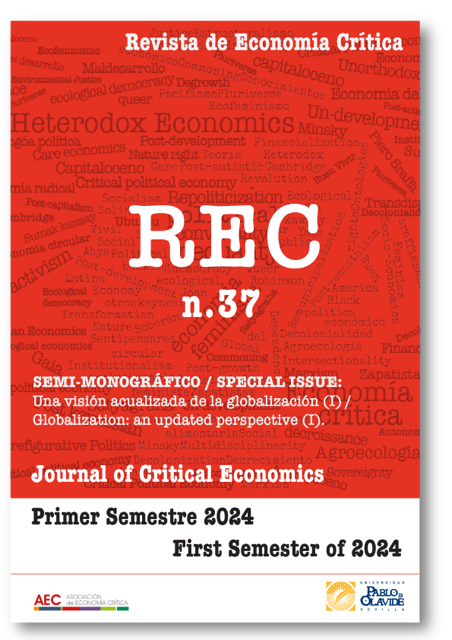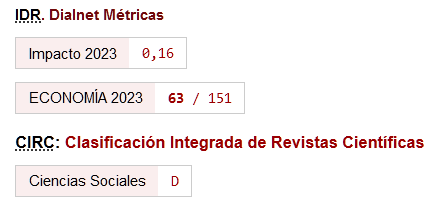Relevant sectors in greenhouse gas emissions in Spain
an input-output approach from the production perspective
DOI:
https://doi.org/10.46661/rec.10696Keywords:
climate policy, environmental impact, input-output analysis, key sectorsAbstract
Using an input–output method, we determine the relevant sectors in greenhouse gas emissions of the Spanish economy. Our approach is based on the responsibility for greenhouse gas emissions from the total production—whether oriented towards intermediate or final demand—of each sector. We classify the productive sectors according to the role they play in the production structure, providing a complementary perspective to the usual methods based on final demand impact. Using the input–output table for the year 2018, the analysis highlights the relevance of 14 sectors in greenhouse gas emissions. Three of these sectors are classified as key—basic metals, road transport, and the chemical sector—due to their significance in both the emissions that they pull in other sectors and the emissions they are pulled to emit. Five sectors are relevant because they are pulled to emit by the rest of the sectors, with electricity production and agriculture standing out. Nine sectors are relevant because of the emissions they pull in other sectors, with food production and construction being the most notable. Remarkably, up to five service sectors are included in this group, whose relevance would have been overlooked by solely examining their direct emissions. Finally, from the perspective of their own demand, all sectors that are also relevant due to being pulled to emit are relevant, including the key sectors, and two that are also relevant for pulling emissions in other sectors. The aviation transport sector is also relevant for its own demand. Based on the information obtained, a series of policy conclusions are derived to guide emission mitigation efforts.
Downloads
References
Acquaye, Adolf A.; Duffy, Aidan P. (2010): "Input-output analysis of Irish construction sector greenhouse gas emissions", Building and Environment 45(3), 784-791. https://doi.org/10.1016/j.buildenv.2009.08.022
Alcántara, Vicent; Padilla, Emilio (2009): "Input-output subsystems and pollution: An application to the service sector and CO2 emissions in Spain", Ecological Economics 68, 905-914. https://doi.org/10.1016/j.ecolecon.2008.07.010
Alcántara, Vicent; Padilla, Emilio (2020): "Key sectors in greenhouse gas emissions in Spain. An alternative input-output analysis", Journal of Industrial Ecology 24(3), 577-588. https://doi.org/10.1111/jiec.12948
Alcántara, Vicent; Padilla, Emilio (2021): "CO2 emissions of the construction sector in Spain during the real estate boom: input-output subsystem analysis and decomposition", Journal of Industrial Ecology, 25(5), 1272-1283. https://doi.org/10.1111/jiec.13127
Baranzini, Andrea; van den Bergh, Jeroen; Carattini, Stefano; Howarth, Richard; Padilla, Emilio; Roca, Jordi (2017): "Seven reasons to use carbon pricing in climate policy", WIREs Climate Change 8(4), 1-17. https://doi.org/10.1002/wcc.462
Comisión Europea (2021): ""Objetivo 55": cumplimiento del objetivo climático de la UE para 2030 en el camino hacia la neutralidad climática", Bruselas, 14.7.2021 COM(2021) 550 final, disponible en https://eur-lex.europa.eu/legal-content/ES/TXT/PDF/?uri=CELEX:52021DC0550&from=EN
Convención Marco de las Naciones Unidas para el Cambio Climático (CMNUCC) (2022): Detailed data by party. Disponible en: https://di.unfccc.int/detailed_data_by_party (acceso 17 de enero de 2022)
Heimler, Alberto (1991): "Linkages and vertical integration in the Chinese economy", Review of Economics and Statistics 73, 261-267. https://doi.org/10.2307/2109516
Hewings, Geoffrey J.D. (1982): "The empirical identification of key sectors in an economy: A regional perspective", The Developing Economies 20 (2), 173-195. https://doi.org/10.1111/j.1746-1049.1982.tb00444.x
Hirschman, Albert O. (1958): The Strategy of Economic Development. Yale University Press, New Haven, C T.
Hubacek, Klaus, Feng, Kuishuang (2023): "Environmentally extended multi-region input-output analysis", en Padilla Rosa, Emilio;
Ramos-Martín, Jesús. (2023) Elgar Encyclopedia of Ecological Economics. Edward Elgar Publishing, Cheltenham, R.U. y Northampton, Massachusetts, EE.UU., pp. 259-264. https://doi.org/10.4337/9781802200416.ch44
Karunaratne, Neil D. (1976): "Quantificacion of Sectoral Developements Prospects in Papua New Guinea Using Tinbergen and Rasmussen Criteria", The Developing Economies 14(3):280-305. https://doi.org/10.1111/j.1746-1049.1976.tb00983.x
Leontief, Wassily W. (1936): "Quantitative Input and Output Relations in the Economic Systems of the United States", The Review of Economics and Statistics 18, 105-125. https://doi.org/10.2307/1927837
Milana, Carlo (1985): "Direct and indirect requirements for gross output in input-output analysis", Metroeconomica 37, 283-292.
https://doi.org/10.1111/j.1467-999X.1985.tb00416.x
Ministerio para la Transición Ecológica y el Reto Demográfico (MITECO) (2021): Plan Nacional Integrado de Energía y Clima 2021-2030 (PNIEC), Boletín oficial del estado, nº 77, Sec. III. Pág. 36797
Ministerio para la Transición Ecológica y el Reto Demográfico (MITECO) (2022): España, Informe Inventarios GEI 1990-2020 (Edición 2022)
OCDE (2021a): Input-Output Tables (IOTs) 2021 ed. Disponible en: https://data.oecd.org/ (acceso 17 de enero de 2022)
OCDE (2021b): Air Emission Accounts. Disponible en: https://data.oecd.org/ (acceso 27 de enero de 2022)
Peters, Glen P. (2008): "From production-based to consumption-based national emission inventores", Ecological Economics, 65(1), 13-23. https://doi.org/10.1016/j.ecolecon.2007.10.014
Piaggio, Matías; Alcántara, Vicent; Padilla, Emilio (2014): "Greenhouse gas emissions and economic structure in Uruguay", Economic Systems Research 26, 155-176. https://doi.org/10.1080/09535314.2013.869559
Rasmussen, Poul N. (1956): Studies in Inter-sectorial Relation. North-Holland Publishing Company
Sonis, Michael, Guilhoto, Joaquim, J.M.; Hewings, Geoggrey. J.D.; Martins, Eduardo B. (1995): "Linkages, key sectors, and structural change: Some new perspectives", The Developing Economies, 33(3), 243-246. https://doi.org/10.1111/j.1746-1049.1995.tb00716.x
Downloads
Published
How to Cite
Issue
Section
License
Copyright (c) 2024 Revista de Economía Crítica

This work is licensed under a Creative Commons Attribution 4.0 International License.
This licence allows third parties to share (copy and redistribute the material in any medium or format) and adapt (remix, transform and create from the material for any purpose, including commercial purposes), provided that authorship and first publication in this journal (The Journal, DOI of the work) is acknowledged, a link to the licence is provided, and it is stated whether changes have been made to the work.







